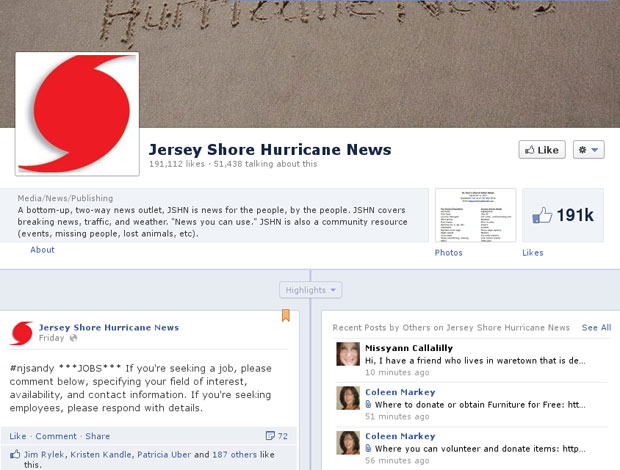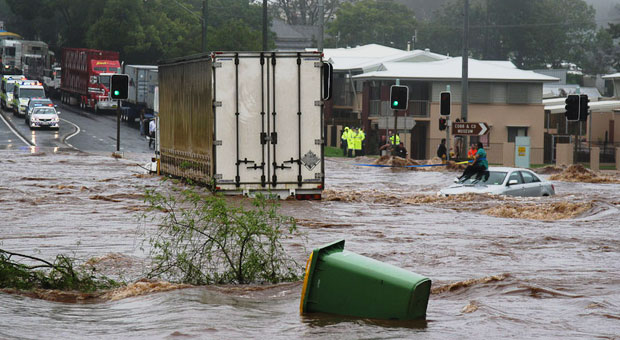
Hurricane Sandy, which struck the U.S.’ Eastern seaboard last October, exemplified the use of socialnetworks in disaster communications. Millions of residents were affected. For many, real-timeinformation was provided through independent, citizen-generated Facebook pages like Jersey Shore Hurricane News and Twitter.
“Harnessing the power of Facebook and Twitter, Jersey Shore Hurricane News wasable to keep people informed in real-time — as events were unfolding,” Justin Auciello,who started Jersey Shore Hurricane News, told TechNewsWorld shortly afterward. Hisbulletin-board page had received 191,000 Likes at the time.

TechNewsWorld featured some of the 21st century citizen-created news sources like those JSHN utilized during Sandy in “When the Lights Go Out, Social Nets Can Be More Than Friends.”
The Credibility of Crowdsourcing
This reliance on social media is new. Governments historically have been in charge of distributing information in a disaster through established emergency management systems — utilizing classic media like television. How are they adapting to the two-way, social media channels now complementing conventional platforms like television, radio and the Web?
“Social media provides an excellent opportunity not only to disseminate urgent emergency information in real time, but also to crowdsource situational information from affected locals on the ground,” said Axel Bruns, Ph.D., associate professor of media and communication at Queensland University of Technology.
Parts of Queensland saw major flooding in 2011, and Twitter was used extensively by police, Bruns found while compiling a report on the use of social media during the disaster.
Emergency services and media organizations were among the most visible on Twitter, partly through retweets, note Bruns and coauthor Jean Burgess in the report.
Leading Twitter accounts, including those from police media bureaus, received about 25 retweets for each message. Those messages primarily focused on situational information and advice that was crucial for public safety purposes.
A police media bureau Twitter account, tagged @QPSMedia, also tackled rumors and misinformation via Twitter — and those tweets were widely retweeted too.
Twitter became a source for mainstream media, according to the report, partly because social network users in the field included photographs and videos in their tweets.
Bruns found that one in every five #qldfloods links was to an image.
“Emergency services around the world are now actively developing their social mediacrisis communication strategies,” Bruns added.

Everyone’s a Reporter
It wasn’t easy for local governments, which traditionally have controlled the dissemination of disasterinformation, to allow communications to become two-way, as happens with social networking.
“Those working in government are concerned about relinquishing control of thedistribution of information,” explained Anthony S. Mangeri, a professor at the American Public University System.
Mangeri, who specializes in emergency management initiatives, was operations chief for the New Jersey Emergency Operations Center during 9/11.
“Protection of one’s brand reputation is an essential element of any good crisis management strategy,” he told TechNewsWorld.
“However, many in government and private sector public affairs are aware that the world has changed, and the methods for collecting and distributing information have also changed,” Mangeri acknowledged.
“Everyone with a cellphone is now a reporter and a videographer, capable of sharing information with the world through various social media channels,” he said.
Local and state government crisis communications plans are not complete unless they include a strategy to monitor and react to social media, said Mangeri.
Coordination Is Critical
Virtual Operations Support Teams are one answer, he suggested. Members of the team keep an eye on social media channels, looking for trends and patterns of information. They then provide analysis for the emergency operations center and respond to posts.
“An emerging value of social media in time of crisis is the ability of emergency operations centers to monitor posted information as an incident unfolds. Virtual Operations Specialists can search for trends and patterns of posted information to analyze the impact of a crisis on the community,” explained Mangeri.
“If interpreted properly, two-way communication via social media provides potential insights into serious unmet human needs, adding a depth to the damage assessment process that was unavailable before,” he said.
Emergency organizations should engage with and respond to public messages received via social network accounts, advises Bruns in his report on the Queensland flooding. An established presence on Twitter is important, as is understanding of user practices like specific hashtags — for example #qldfloods. Training is important.
In addition coordination must take place between different emergency and government services — as well as media — to avoid conflicting messages, he says.
Organizations need to take the time to develop written protocols, policies and procedures when implementing a social media disaster plan, said Mangeri. “Organizations and corporations that do not currently have social media as part of their crisis communications plan should begin now.”




















































